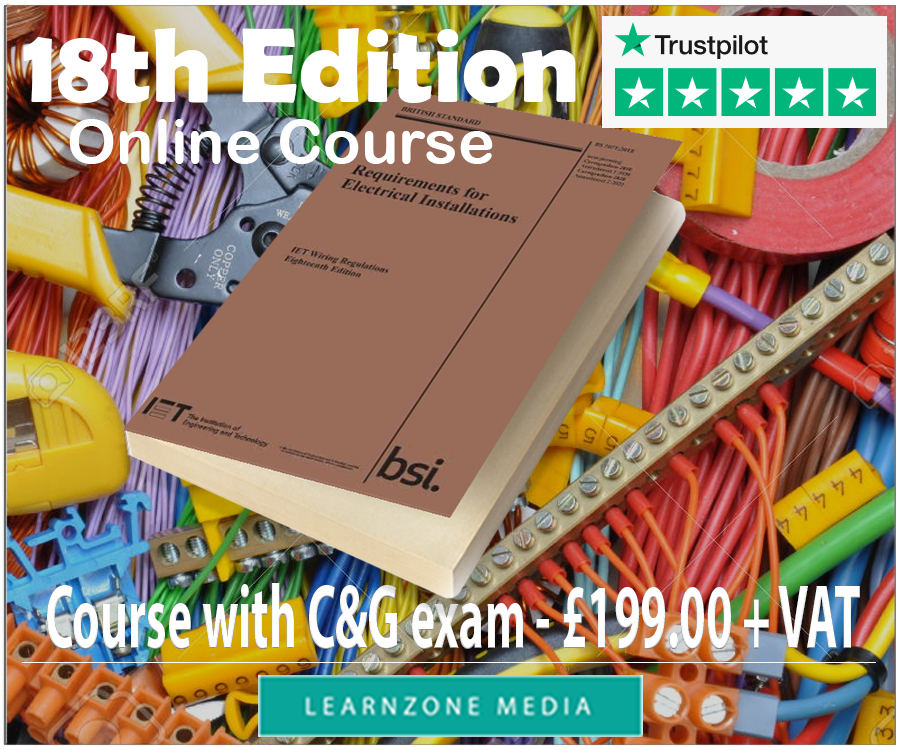MOCK EXAM from past papers - No. 1
This is a mock exam for the 18th edition (C&G 2382-22) exam. All the questions are from past exam papers. In order to simulate the exam conditions we recommend using a stopwatch set to two hour. During that time you need to answer all 60 questions. Remember this is an open book exam so feel free to use the 18th edition of Wiring Regulations book.
You will find the correct answers on the last page of this mock exam. Good luck!
1. To which of the following electrical installations does BS 7671 not apply?
a. Agricultural and horticultural premises
b. Construction sites
c. Systems for the distribution of electricity to the public
d. Caravans, caravan parks and similar locations
2. BS 7671 relates to the permanent and temporary installations for
a. equipment on board ships
b. equipment of aircraft
c. construction sites
d. railway traction equipment
3. An a.c. voltage of 90V between conductors is classified as
a. extra-low voltage
b. low voltage
c. safety extra-low voltage
d. reduced low voltage
4. Which of the following types of installations is not included in the special installations recognised by BS 7671?
a. Swimming pools
b. Petrol Station
c. Agricultural
d. Saunas
5. The maximum accessible distance that it should be assumed a person can reach when standing on a surface is
a. 0.75m
b. 1.25m
c. 2.50m
d. 3.00m
6. BS 7671 requires that the designer of a new installation shall
a. have at least three years experience
b. recommend the interval to the first periodic inspection and test
c. complete a periodic test report
d. have a copy of BS 7671
7. Non-sheathed cables for fixed wiring, other than protective conductors, should always be installed in
a. dry conditions
b. trenches
c. conduit or trunking
d. sub-zero temperatures
8. A final circuit is the wiring between the
a. main cut-out and the energy meter
b. main switch and the distribution board
c. distribution board and the current-using equipment (Definitions page 24)
d. consumer's main earth terminal and circuit protective device
9. The prospective short circuit current at the origin of the consumer's installation must be taken into account when
a. estimating the external earth loop impedance
b. applying diversity factor for the installation
c. selecting the system of earthing for the supply
d. selecting the type of overcurrent protective device to be installed
10. A system is defined as
a. the kWh meter and an installation
b. the distribution cables to an installation
c. the consumer's terminals of an installation
d. a single source of energy and an installation
11. The total number of socket-outlets that may be connected to an unfused spur is
a. one single or one twin socket-outlet
b. equal to the total number of socket-outlets on the ring
c. equal to half the number of socket-outlets on the ring
d. unlimited
12. Residual current circuit breakers shall not be used on a TN system where a circuit incorporates
a. protective conductors
b. exposed-conductive-parts
c. earthing conductors
d. PEN conductors
13. Which of the following is a method of providing fault protection?
a. Placing out of reach
b. Double insulation
c. Protection by obstacles
d. Insulation of live parts
14. In addition to regular maintenance of an installation, which of the following is not an essential requirement?
a. Periodic inspection and testing may be readily and safely carried out
b. The name and address of the contractor is permanently displayed adjacent to the distribution board
c. The reliability of the equipment is sustained
d. Protective measures for safety remain effective
15. Where SELV is used to provide basic and fault protection, the nominal voltage must not exceed.
a. 12V a.c.
b. 25V a.c.
c. 50V a.c.
d. 110V a.c





